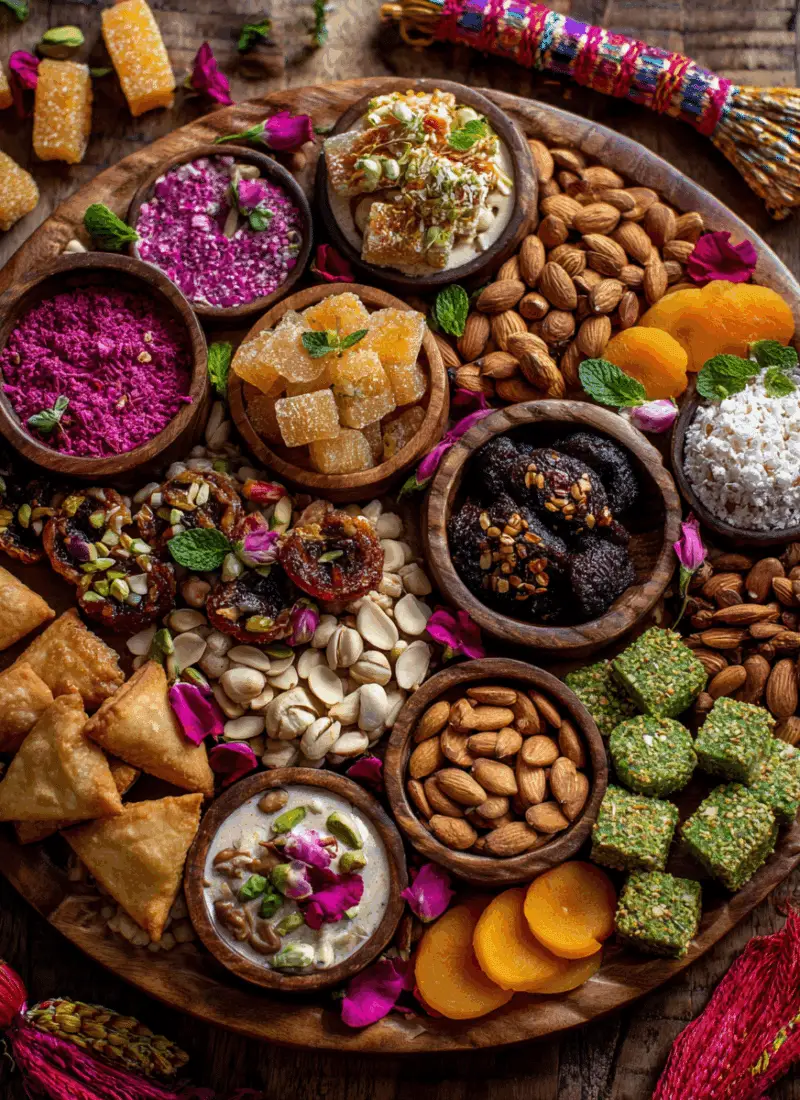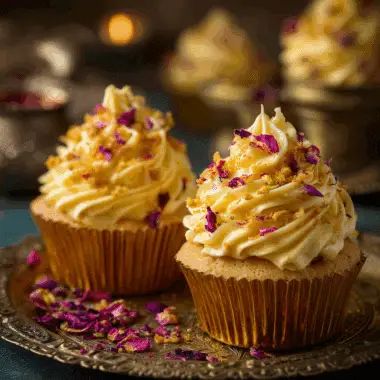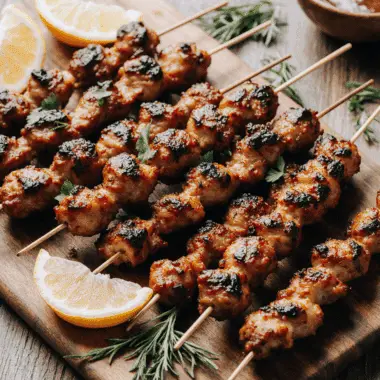A Mithai Charcuterie Board brings a colorful, cultural twist to the trending charcuterie concept by spotlighting traditional Indian sweets and snacks in an elegant, buffet-style arrangement. Perfect for festive occasions like Diwali, Eid, weddings, or even modern gatherings, this board balances rich sweets (mithai) with salty, crunchy snacks and tropical fruits, all beautifully displayed.
FULL RECIPE
Ingredients
1.Assorted Indian Mithai (choose a variety for texture and color):
- Kaju katli
- Gulab jamun
- Rasgulla
- Besan ladoo
- Barfi (coconut, chocolate, or pista)
- Jalebi (mini or spiral pieces)
2.Dry Fruits and Nuts:
- Cashews
- Almonds
- Pistachios
- Golden raisins
- Dates (stuffed with nuts or plain)
3.Savory Indian Snacks:
- Mini samosas
- Mathri (spiced crackers)
- Namak pare
- Murukku or chakli
- Masala peanuts
4.Fresh Fruits (for color and freshness):
- Grapes
- Kiwi slices
- Strawberries
- Pomegranate arils
- Mango cubes
5.Cheese (optional fusion element):
- Paneer cubes (lightly grilled or plain)
- Mild cheddar or mozzarella cubes
6.Garnishes and Extras:
- Edible silver foil (varak)
- Rose petals (fresh or dried)
- Mint leaves
- Cardamom pods or cinnamon sticks (for fragrance)
- Mini serving bowls for chutney or rose syrup
Directions
- Choose Your Board or Tray:
Select a large wooden charcuterie board, marble slab, or decorative tray as your base. Ensure it’s clean and dry. - Arrange Larger Items First:
Place the mithai (sweets) in various parts of the board, starting with large items like gulab jamun, rasgulla, or large barfi blocks. Use small ramekins if they have syrup. - Add Savory Snacks:
Strategically place savory elements like mini samosas, mathri, and masala peanuts to contrast the sweetness and break the flavor monotony. - Distribute Dry Fruits & Nuts:
Scatter nuts and dry fruits in small clusters or place them in tiny bowls to add texture and richness. - Incorporate Fresh Fruits:
Add pops of color and freshness with neatly arranged fruit slices. Fan out kiwi, pile grapes, or sprinkle pomegranate arils over mithai for a vibrant effect. - Add Cheese for a Fusion Touch (Optional):
If using cheese, place cubes or skewers between mithai and savory bites to create a unique Indo-Western flavor profile. - Garnish for Elegance:
Finish with decorative garnishes like edible rose petals, mint sprigs, or silver leaf for a luxurious look. Use aromatic spices like cinnamon or cardamom for scent and style. - Serve Immediately or Chill Briefly:
This board is best served fresh but can be kept in the fridge for 15–20 minutes before guests arrive. Avoid long refrigeration to prevent condensation or mithai hardening.
Nutrition Facts
- Calories: 520 kcal
- Total Fat: 24g
- Saturated Fat: 9g
- Trans Fat: 0g
- Cholesterol: 25mg
- Sodium: 210mg
- Total Carbohydrates: 70g
- Dietary Fiber: 4g
- Sugars: 45g
- Protein: 9g
- Vitamin A: 6% DV
- Vitamin C: 12% DV
- Calcium: 10% DV
- Iron: 15% DV
Cultural Significance of the Mithai Charcuterie Board
The Mithai Charcuterie Board is more than just a visual treat—it’s a celebration of Indian heritage and hospitality. Traditional sweets like barfi, ladoo, and gulab jamun symbolize joy and are often gifted or shared during religious festivals and milestones. By arranging these beloved treats in a charcuterie format, the board becomes a beautiful fusion of Eastern tradition and Western presentation, making it ideal for modern events while retaining deep cultural roots. It brings people together through the shared experience of nostalgia and novelty, creating a centerpiece that invites storytelling and community.
Flavor and Texture Variety
One of the strongest appeals of a Mithai Charcuterie Board is the spectrum of flavors and textures it offers. From syrup-soaked rasgulla to crumbly besan ladoos and crisp mathri, each component adds a unique mouthfeel and taste profile. The balance between sweet, salty, crunchy, creamy, and juicy ensures every bite surprises and delights. Including both dairy-based and flour-based sweets, as well as dry snacks and fresh fruit, helps ensure that the board appeals to a wide audience and doesn’t overwhelm the palate with just sugar.
Visual Appeal and Presentation
Mithai is inherently colorful, and when arranged thoughtfully, it creates an eye-catching mosaic of hues and shapes. This board plays with symmetry, contrast, and negative space—arranging sweets of different shapes (round ladoos, diamond-shaped kaju katli, spiraled jalebi) alongside vibrant fruits and golden nuts. Garnishes like rose petals, silver foil (varak), and mint leaves elevate the board’s elegance. The result is not only delicious but also Instagram-worthy, making it perfect for weddings, housewarmings, and festive soirées.
Customizability and Personalization
A Mithai Charcuterie Board is highly adaptable to different tastes, dietary restrictions, and seasonal availability. Those looking to reduce sugar can opt for sugar-free mithai or add more fruits and nuts. Vegan guests can be accommodated by choosing dairy-free sweets like coconut barfi or dry fig rolls. You can also tailor the board to regional themes—such as South Indian (with mysore pak and murukku) or Bengali (with sandesh and mishti doi)—giving hosts creative flexibility. This makes the board not just inclusive but also reflective of personal or family traditions.
Health Benefits of Key Ingredients
While mithai is often considered indulgent, several components of the board bring nutritional value. Nuts like almonds and pistachios offer healthy fats, protein, and micronutrients such as magnesium and vitamin E. Dry fruits like dates and raisins are rich in fiber and natural sugars that release energy gradually. Spices used in mithai—such as cardamom, saffron, and cinnamon—offer antioxidant properties and aid digestion. When combined with fresh fruits, the board delivers not just indulgence but also elements of wellness, especially when consumed mindfully.
Serving Tips for Maximum Enjoyment
To keep textures and temperatures just right, it’s best to assemble the Mithai Charcuterie Board shortly before serving. Keep syrupy sweets like gulab jamun or rasgulla in small bowls to avoid sogginess. Serve with toothpicks or mini tongs for easy, hygienic self-service. If the gathering is formal, labeling each item with small tags can enhance both presentation and awareness (especially helpful for guests with allergies or dietary restrictions). A balance of dry and moist items, spaced out to avoid flavor bleed, ensures both structure and ease of consumption.
Creative Fusion Pairings
Adding a fusion element to the board can surprise and impress guests. Mild cheeses like paneer cubes or soft mozzarella can complement savory snacks and subtly sweet items. Crackers or savory biscuits can be included for texture contrast. For beverages, pair the board with masala chai, cardamom-spiced coffee, or even sparkling wine for a global twist. You can also offer mini dipping bowls of rose syrup, saffron milk, or fruit chutney to elevate each bite and encourage guests to mix and match flavors.
Storage and Leftover Management
Not everything on the Mithai Charcuterie Board requires refrigeration, but proper storage ensures freshness. Dry sweets like barfi or ladoo can be kept in airtight containers at room temperature for a few days, while milk-based or syrupy mithai should be refrigerated and consumed within 2–3 days. Savory snacks may go stale if left out too long, so store extras in sealed jars. Leftover fruits can be repurposed into smoothies, while sweets can be chopped and mixed into ice cream or yogurt for indulgent desserts.
Seasonal and Festive Variations
The Mithai Charcuterie Board can be modified to align with various festivals and seasons. For Diwali, include saffron-tinged sweets and firecracker-themed decor. During Eid, opt for traditional treats like sheer khurma or dates stuffed with almonds. For Raksha Bandhan or weddings, incorporate silver-coated dry fruits and color-coordinated sweets. In summer, lighter sweets like coconut barfi and mango-based desserts shine, while winter boards can feature ghee-rich halwas and roasted nuts for warmth. This flexibility allows the board to evolve throughout the year.
Kid-Friendly Adaptations
To make the board more appealing to children, focus on milder and fun-shaped sweets. Mini jalebis, chocolate barfi, and milk peda molded into animal or cartoon shapes can attract young eyes. Offer fruit kabobs and nut-free options for safety, and consider small cups of flavored milk or lassi as complementary drinks. By simplifying the flavors and presentation, you can create a version that is festive yet safe and exciting for kids, making them feel included in the celebration.
Conclusion
The Mithai Charcuterie Board is more than a dessert spread—it’s a multi-sensory experience that honors tradition while embracing modern aesthetics. Whether served at intimate family gatherings or large festive parties, it creates moments of joy, sparks conversation, and showcases the richness of Indian culinary artistry. With endless possibilities for customization, it encourages creativity in presentation, thoughtfulness in selection, and a warm sense of community with every bite. Perfectly balancing elegance with indulgence, it’s a stylish way to celebrate heritage one sweet bite at a time.








